Policy Analysis Application in Healthcare: Case Study Analysis
VerifiedAdded on 2022/11/10
|12
|3193
|484
Report
AI Summary
This report provides a detailed analysis of healthcare policy, focusing on the application of key policy analysis processes such as identification and definition, health technology assessment, evidence-based medicine, and political feasibility. It examines three distinct cases: the Trans-Pacific Partnership Agreement, cross-national analysis of expenditure in 27 European nations, and California's Proposition 63, which concerns gun control. The report evaluates how each policy analysis process can be applied to these cases to address healthcare challenges, improve decision-making, and enhance the quality of care. It also introduces a fourth policy process, evidence-based medicine, and discusses its importance in optimizing healthcare outcomes through systematic evaluation and stakeholder engagement.
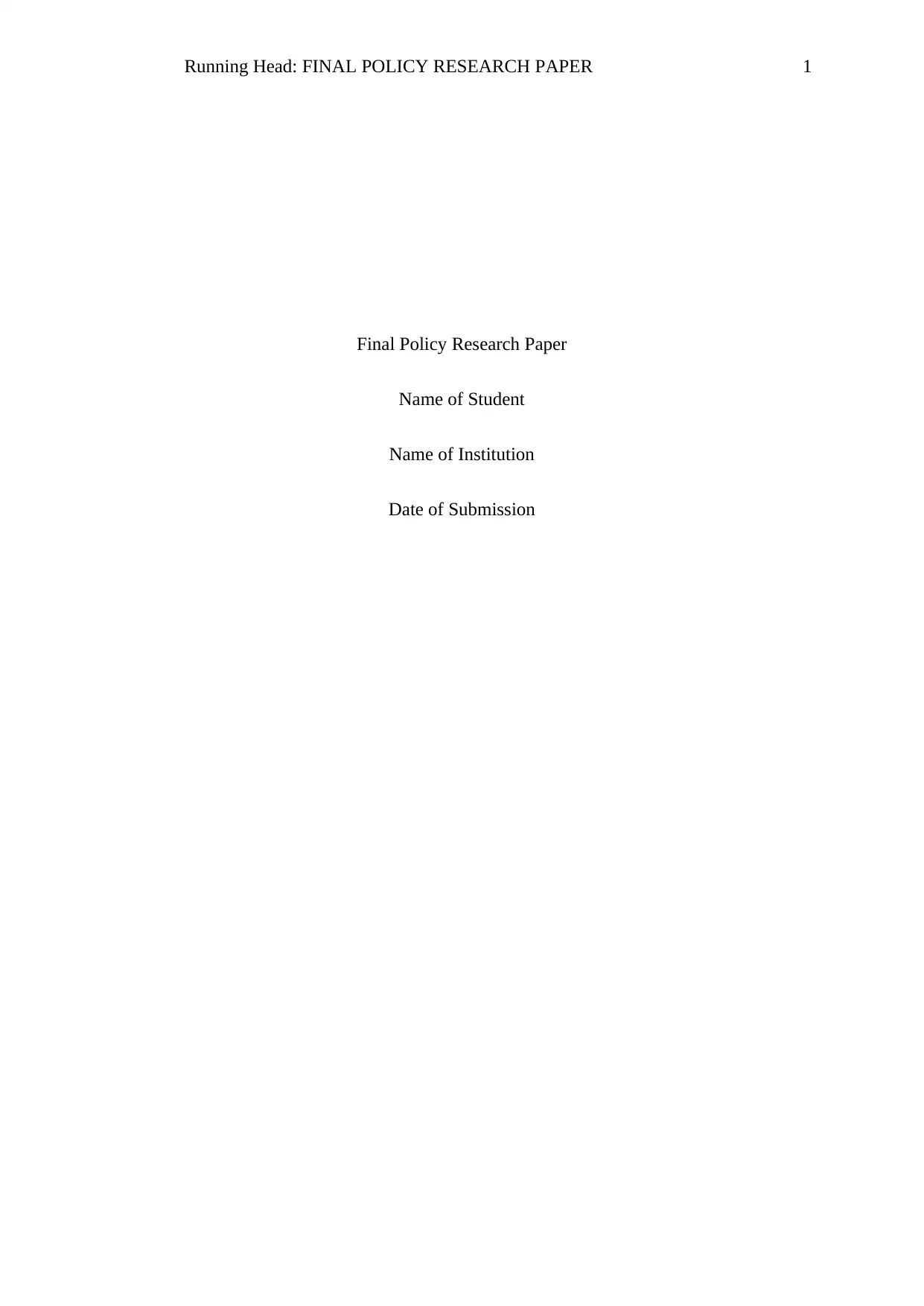
Running Head: FINAL POLICY RESEARCH PAPER 1
Final Policy Research Paper
Name of Student
Name of Institution
Date of Submission
Final Policy Research Paper
Name of Student
Name of Institution
Date of Submission
Paraphrase This Document
Need a fresh take? Get an instant paraphrase of this document with our AI Paraphraser
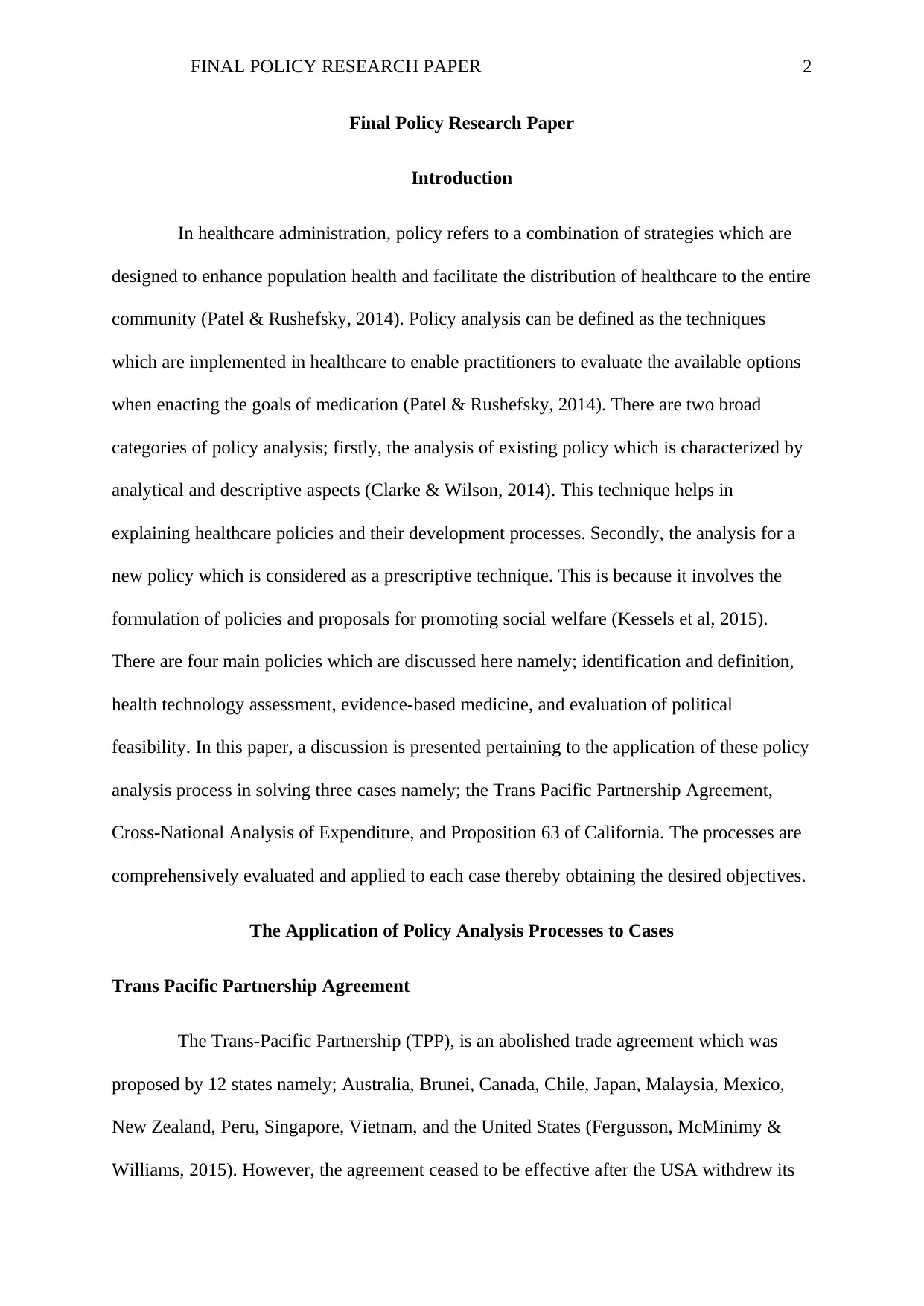
FINAL POLICY RESEARCH PAPER 2
Final Policy Research Paper
Introduction
In healthcare administration, policy refers to a combination of strategies which are
designed to enhance population health and facilitate the distribution of healthcare to the entire
community (Patel & Rushefsky, 2014). Policy analysis can be defined as the techniques
which are implemented in healthcare to enable practitioners to evaluate the available options
when enacting the goals of medication (Patel & Rushefsky, 2014). There are two broad
categories of policy analysis; firstly, the analysis of existing policy which is characterized by
analytical and descriptive aspects (Clarke & Wilson, 2014). This technique helps in
explaining healthcare policies and their development processes. Secondly, the analysis for a
new policy which is considered as a prescriptive technique. This is because it involves the
formulation of policies and proposals for promoting social welfare (Kessels et al, 2015).
There are four main policies which are discussed here namely; identification and definition,
health technology assessment, evidence-based medicine, and evaluation of political
feasibility. In this paper, a discussion is presented pertaining to the application of these policy
analysis process in solving three cases namely; the Trans Pacific Partnership Agreement,
Cross-National Analysis of Expenditure, and Proposition 63 of California. The processes are
comprehensively evaluated and applied to each case thereby obtaining the desired objectives.
The Application of Policy Analysis Processes to Cases
Trans Pacific Partnership Agreement
The Trans-Pacific Partnership (TPP), is an abolished trade agreement which was
proposed by 12 states namely; Australia, Brunei, Canada, Chile, Japan, Malaysia, Mexico,
New Zealand, Peru, Singapore, Vietnam, and the United States (Fergusson, McMinimy &
Williams, 2015). However, the agreement ceased to be effective after the USA withdrew its
Final Policy Research Paper
Introduction
In healthcare administration, policy refers to a combination of strategies which are
designed to enhance population health and facilitate the distribution of healthcare to the entire
community (Patel & Rushefsky, 2014). Policy analysis can be defined as the techniques
which are implemented in healthcare to enable practitioners to evaluate the available options
when enacting the goals of medication (Patel & Rushefsky, 2014). There are two broad
categories of policy analysis; firstly, the analysis of existing policy which is characterized by
analytical and descriptive aspects (Clarke & Wilson, 2014). This technique helps in
explaining healthcare policies and their development processes. Secondly, the analysis for a
new policy which is considered as a prescriptive technique. This is because it involves the
formulation of policies and proposals for promoting social welfare (Kessels et al, 2015).
There are four main policies which are discussed here namely; identification and definition,
health technology assessment, evidence-based medicine, and evaluation of political
feasibility. In this paper, a discussion is presented pertaining to the application of these policy
analysis process in solving three cases namely; the Trans Pacific Partnership Agreement,
Cross-National Analysis of Expenditure, and Proposition 63 of California. The processes are
comprehensively evaluated and applied to each case thereby obtaining the desired objectives.
The Application of Policy Analysis Processes to Cases
Trans Pacific Partnership Agreement
The Trans-Pacific Partnership (TPP), is an abolished trade agreement which was
proposed by 12 states namely; Australia, Brunei, Canada, Chile, Japan, Malaysia, Mexico,
New Zealand, Peru, Singapore, Vietnam, and the United States (Fergusson, McMinimy &
Williams, 2015). However, the agreement ceased to be effective after the USA withdrew its
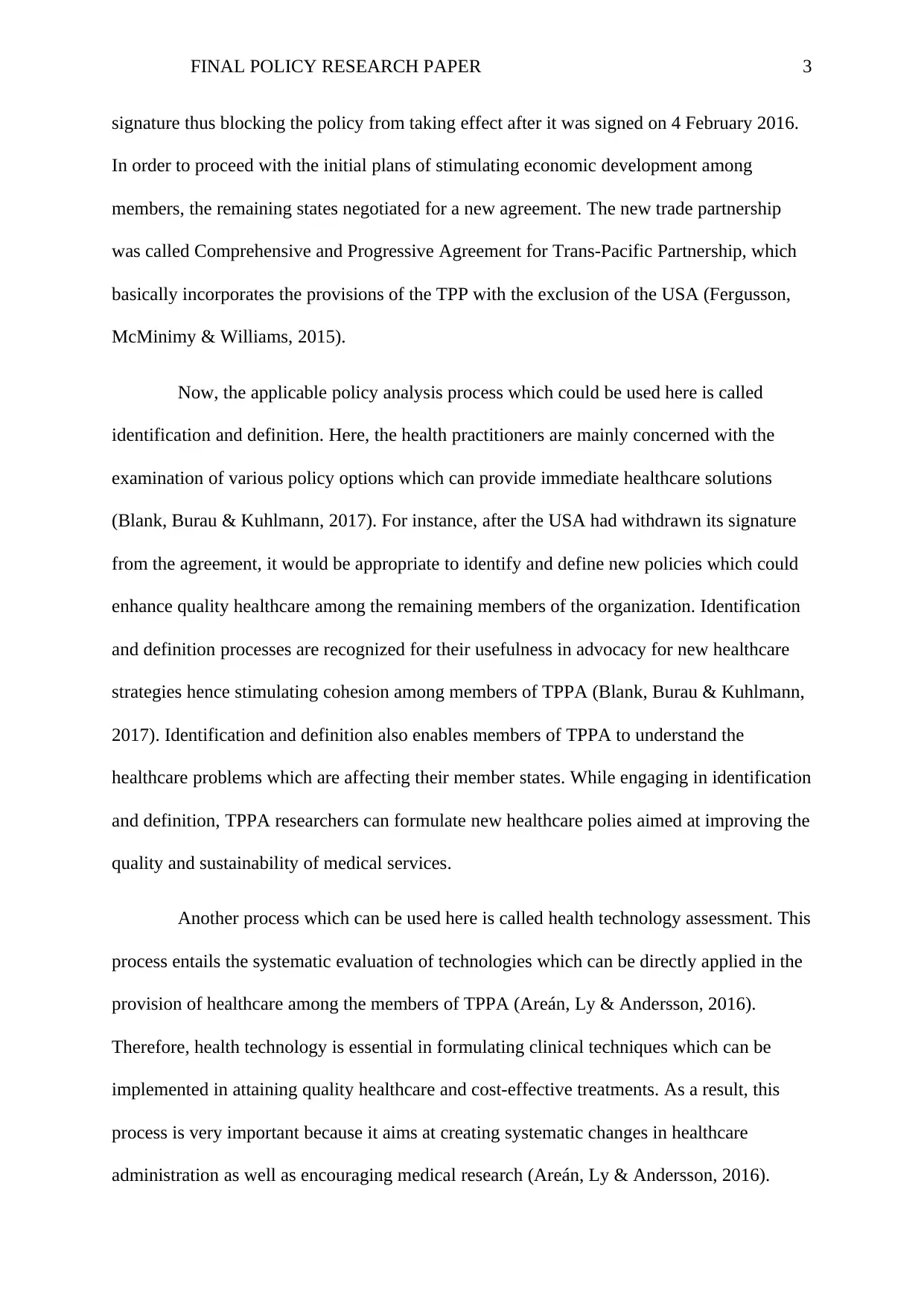
FINAL POLICY RESEARCH PAPER 3
signature thus blocking the policy from taking effect after it was signed on 4 February 2016.
In order to proceed with the initial plans of stimulating economic development among
members, the remaining states negotiated for a new agreement. The new trade partnership
was called Comprehensive and Progressive Agreement for Trans-Pacific Partnership, which
basically incorporates the provisions of the TPP with the exclusion of the USA (Fergusson,
McMinimy & Williams, 2015).
Now, the applicable policy analysis process which could be used here is called
identification and definition. Here, the health practitioners are mainly concerned with the
examination of various policy options which can provide immediate healthcare solutions
(Blank, Burau & Kuhlmann, 2017). For instance, after the USA had withdrawn its signature
from the agreement, it would be appropriate to identify and define new policies which could
enhance quality healthcare among the remaining members of the organization. Identification
and definition processes are recognized for their usefulness in advocacy for new healthcare
strategies hence stimulating cohesion among members of TPPA (Blank, Burau & Kuhlmann,
2017). Identification and definition also enables members of TPPA to understand the
healthcare problems which are affecting their member states. While engaging in identification
and definition, TPPA researchers can formulate new healthcare polies aimed at improving the
quality and sustainability of medical services.
Another process which can be used here is called health technology assessment. This
process entails the systematic evaluation of technologies which can be directly applied in the
provision of healthcare among the members of TPPA (Areán, Ly & Andersson, 2016).
Therefore, health technology is essential in formulating clinical techniques which can be
implemented in attaining quality healthcare and cost-effective treatments. As a result, this
process is very important because it aims at creating systematic changes in healthcare
administration as well as encouraging medical research (Areán, Ly & Andersson, 2016).
signature thus blocking the policy from taking effect after it was signed on 4 February 2016.
In order to proceed with the initial plans of stimulating economic development among
members, the remaining states negotiated for a new agreement. The new trade partnership
was called Comprehensive and Progressive Agreement for Trans-Pacific Partnership, which
basically incorporates the provisions of the TPP with the exclusion of the USA (Fergusson,
McMinimy & Williams, 2015).
Now, the applicable policy analysis process which could be used here is called
identification and definition. Here, the health practitioners are mainly concerned with the
examination of various policy options which can provide immediate healthcare solutions
(Blank, Burau & Kuhlmann, 2017). For instance, after the USA had withdrawn its signature
from the agreement, it would be appropriate to identify and define new policies which could
enhance quality healthcare among the remaining members of the organization. Identification
and definition processes are recognized for their usefulness in advocacy for new healthcare
strategies hence stimulating cohesion among members of TPPA (Blank, Burau & Kuhlmann,
2017). Identification and definition also enables members of TPPA to understand the
healthcare problems which are affecting their member states. While engaging in identification
and definition, TPPA researchers can formulate new healthcare polies aimed at improving the
quality and sustainability of medical services.
Another process which can be used here is called health technology assessment. This
process entails the systematic evaluation of technologies which can be directly applied in the
provision of healthcare among the members of TPPA (Areán, Ly & Andersson, 2016).
Therefore, health technology is essential in formulating clinical techniques which can be
implemented in attaining quality healthcare and cost-effective treatments. As a result, this
process is very important because it aims at creating systematic changes in healthcare
administration as well as encouraging medical research (Areán, Ly & Andersson, 2016).
⊘ This is a preview!⊘
Do you want full access?
Subscribe today to unlock all pages.

Trusted by 1+ million students worldwide
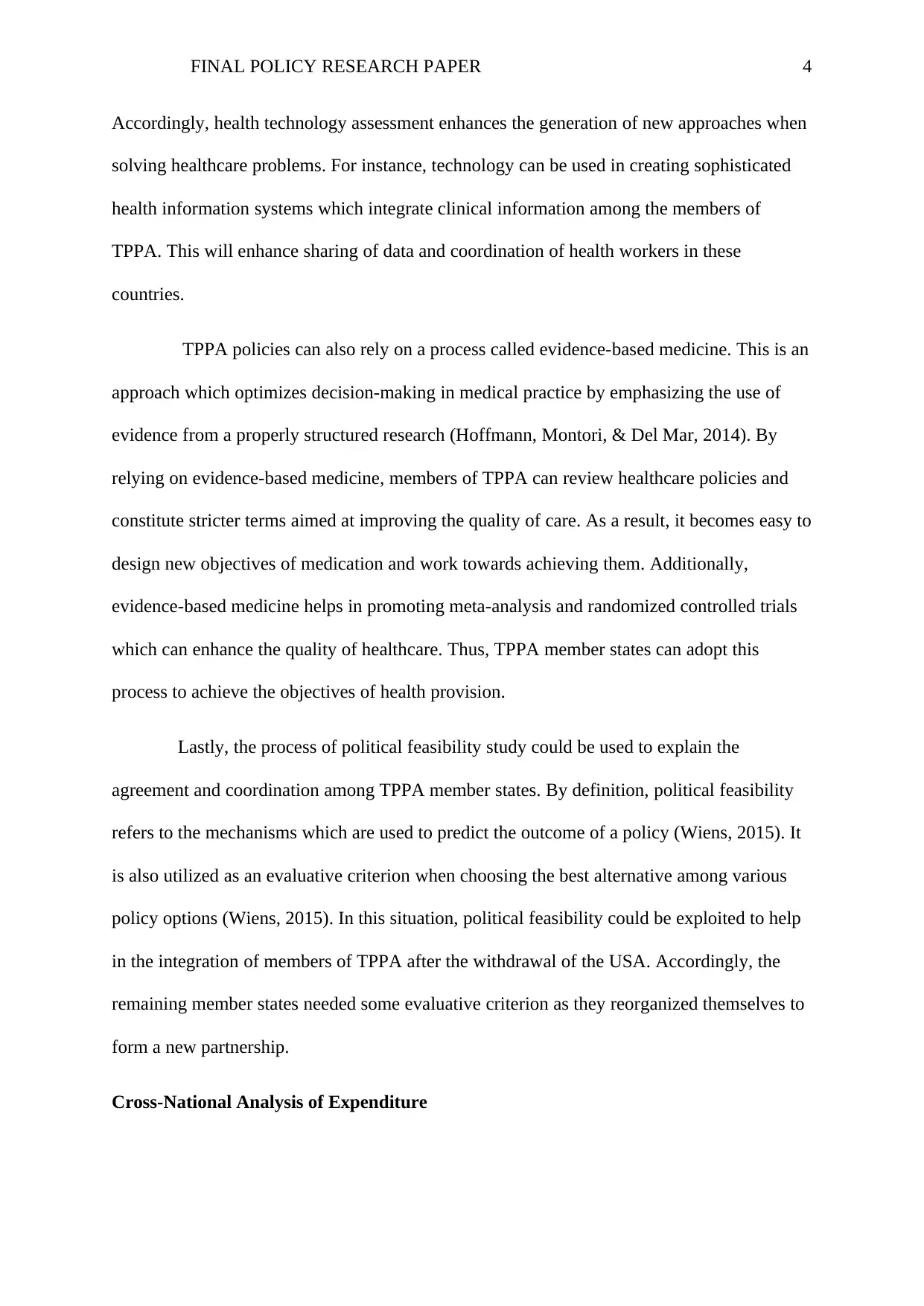
FINAL POLICY RESEARCH PAPER 4
Accordingly, health technology assessment enhances the generation of new approaches when
solving healthcare problems. For instance, technology can be used in creating sophisticated
health information systems which integrate clinical information among the members of
TPPA. This will enhance sharing of data and coordination of health workers in these
countries.
TPPA policies can also rely on a process called evidence-based medicine. This is an
approach which optimizes decision-making in medical practice by emphasizing the use of
evidence from a properly structured research (Hoffmann, Montori, & Del Mar, 2014). By
relying on evidence-based medicine, members of TPPA can review healthcare policies and
constitute stricter terms aimed at improving the quality of care. As a result, it becomes easy to
design new objectives of medication and work towards achieving them. Additionally,
evidence-based medicine helps in promoting meta-analysis and randomized controlled trials
which can enhance the quality of healthcare. Thus, TPPA member states can adopt this
process to achieve the objectives of health provision.
Lastly, the process of political feasibility study could be used to explain the
agreement and coordination among TPPA member states. By definition, political feasibility
refers to the mechanisms which are used to predict the outcome of a policy (Wiens, 2015). It
is also utilized as an evaluative criterion when choosing the best alternative among various
policy options (Wiens, 2015). In this situation, political feasibility could be exploited to help
in the integration of members of TPPA after the withdrawal of the USA. Accordingly, the
remaining member states needed some evaluative criterion as they reorganized themselves to
form a new partnership.
Cross-National Analysis of Expenditure
Accordingly, health technology assessment enhances the generation of new approaches when
solving healthcare problems. For instance, technology can be used in creating sophisticated
health information systems which integrate clinical information among the members of
TPPA. This will enhance sharing of data and coordination of health workers in these
countries.
TPPA policies can also rely on a process called evidence-based medicine. This is an
approach which optimizes decision-making in medical practice by emphasizing the use of
evidence from a properly structured research (Hoffmann, Montori, & Del Mar, 2014). By
relying on evidence-based medicine, members of TPPA can review healthcare policies and
constitute stricter terms aimed at improving the quality of care. As a result, it becomes easy to
design new objectives of medication and work towards achieving them. Additionally,
evidence-based medicine helps in promoting meta-analysis and randomized controlled trials
which can enhance the quality of healthcare. Thus, TPPA member states can adopt this
process to achieve the objectives of health provision.
Lastly, the process of political feasibility study could be used to explain the
agreement and coordination among TPPA member states. By definition, political feasibility
refers to the mechanisms which are used to predict the outcome of a policy (Wiens, 2015). It
is also utilized as an evaluative criterion when choosing the best alternative among various
policy options (Wiens, 2015). In this situation, political feasibility could be exploited to help
in the integration of members of TPPA after the withdrawal of the USA. Accordingly, the
remaining member states needed some evaluative criterion as they reorganized themselves to
form a new partnership.
Cross-National Analysis of Expenditure
Paraphrase This Document
Need a fresh take? Get an instant paraphrase of this document with our AI Paraphraser
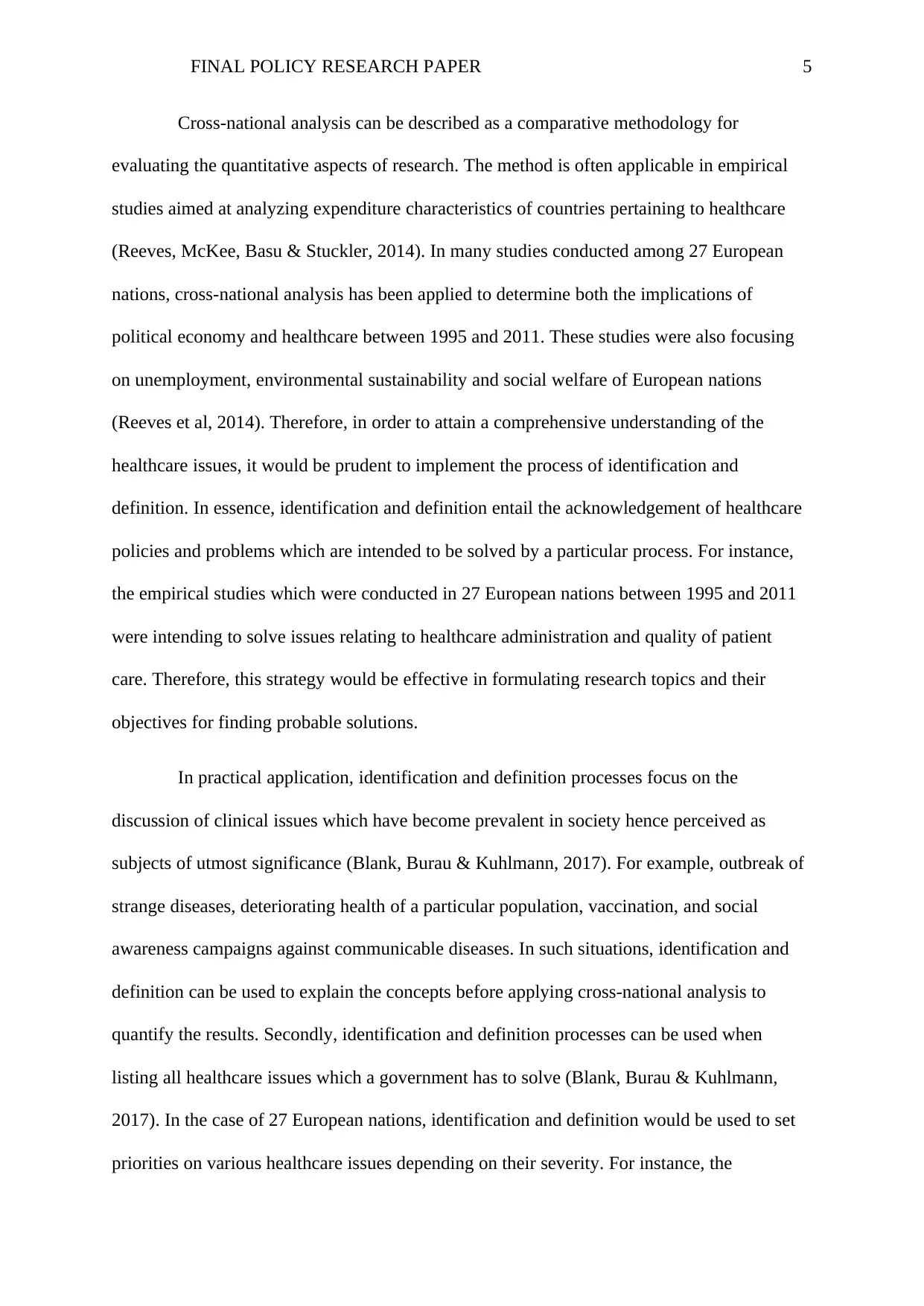
FINAL POLICY RESEARCH PAPER 5
Cross-national analysis can be described as a comparative methodology for
evaluating the quantitative aspects of research. The method is often applicable in empirical
studies aimed at analyzing expenditure characteristics of countries pertaining to healthcare
(Reeves, McKee, Basu & Stuckler, 2014). In many studies conducted among 27 European
nations, cross-national analysis has been applied to determine both the implications of
political economy and healthcare between 1995 and 2011. These studies were also focusing
on unemployment, environmental sustainability and social welfare of European nations
(Reeves et al, 2014). Therefore, in order to attain a comprehensive understanding of the
healthcare issues, it would be prudent to implement the process of identification and
definition. In essence, identification and definition entail the acknowledgement of healthcare
policies and problems which are intended to be solved by a particular process. For instance,
the empirical studies which were conducted in 27 European nations between 1995 and 2011
were intending to solve issues relating to healthcare administration and quality of patient
care. Therefore, this strategy would be effective in formulating research topics and their
objectives for finding probable solutions.
In practical application, identification and definition processes focus on the
discussion of clinical issues which have become prevalent in society hence perceived as
subjects of utmost significance (Blank, Burau & Kuhlmann, 2017). For example, outbreak of
strange diseases, deteriorating health of a particular population, vaccination, and social
awareness campaigns against communicable diseases. In such situations, identification and
definition can be used to explain the concepts before applying cross-national analysis to
quantify the results. Secondly, identification and definition processes can be used when
listing all healthcare issues which a government has to solve (Blank, Burau & Kuhlmann,
2017). In the case of 27 European nations, identification and definition would be used to set
priorities on various healthcare issues depending on their severity. For instance, the
Cross-national analysis can be described as a comparative methodology for
evaluating the quantitative aspects of research. The method is often applicable in empirical
studies aimed at analyzing expenditure characteristics of countries pertaining to healthcare
(Reeves, McKee, Basu & Stuckler, 2014). In many studies conducted among 27 European
nations, cross-national analysis has been applied to determine both the implications of
political economy and healthcare between 1995 and 2011. These studies were also focusing
on unemployment, environmental sustainability and social welfare of European nations
(Reeves et al, 2014). Therefore, in order to attain a comprehensive understanding of the
healthcare issues, it would be prudent to implement the process of identification and
definition. In essence, identification and definition entail the acknowledgement of healthcare
policies and problems which are intended to be solved by a particular process. For instance,
the empirical studies which were conducted in 27 European nations between 1995 and 2011
were intending to solve issues relating to healthcare administration and quality of patient
care. Therefore, this strategy would be effective in formulating research topics and their
objectives for finding probable solutions.
In practical application, identification and definition processes focus on the
discussion of clinical issues which have become prevalent in society hence perceived as
subjects of utmost significance (Blank, Burau & Kuhlmann, 2017). For example, outbreak of
strange diseases, deteriorating health of a particular population, vaccination, and social
awareness campaigns against communicable diseases. In such situations, identification and
definition can be used to explain the concepts before applying cross-national analysis to
quantify the results. Secondly, identification and definition processes can be used when
listing all healthcare issues which a government has to solve (Blank, Burau & Kuhlmann,
2017). In the case of 27 European nations, identification and definition would be used to set
priorities on various healthcare issues depending on their severity. For instance, the
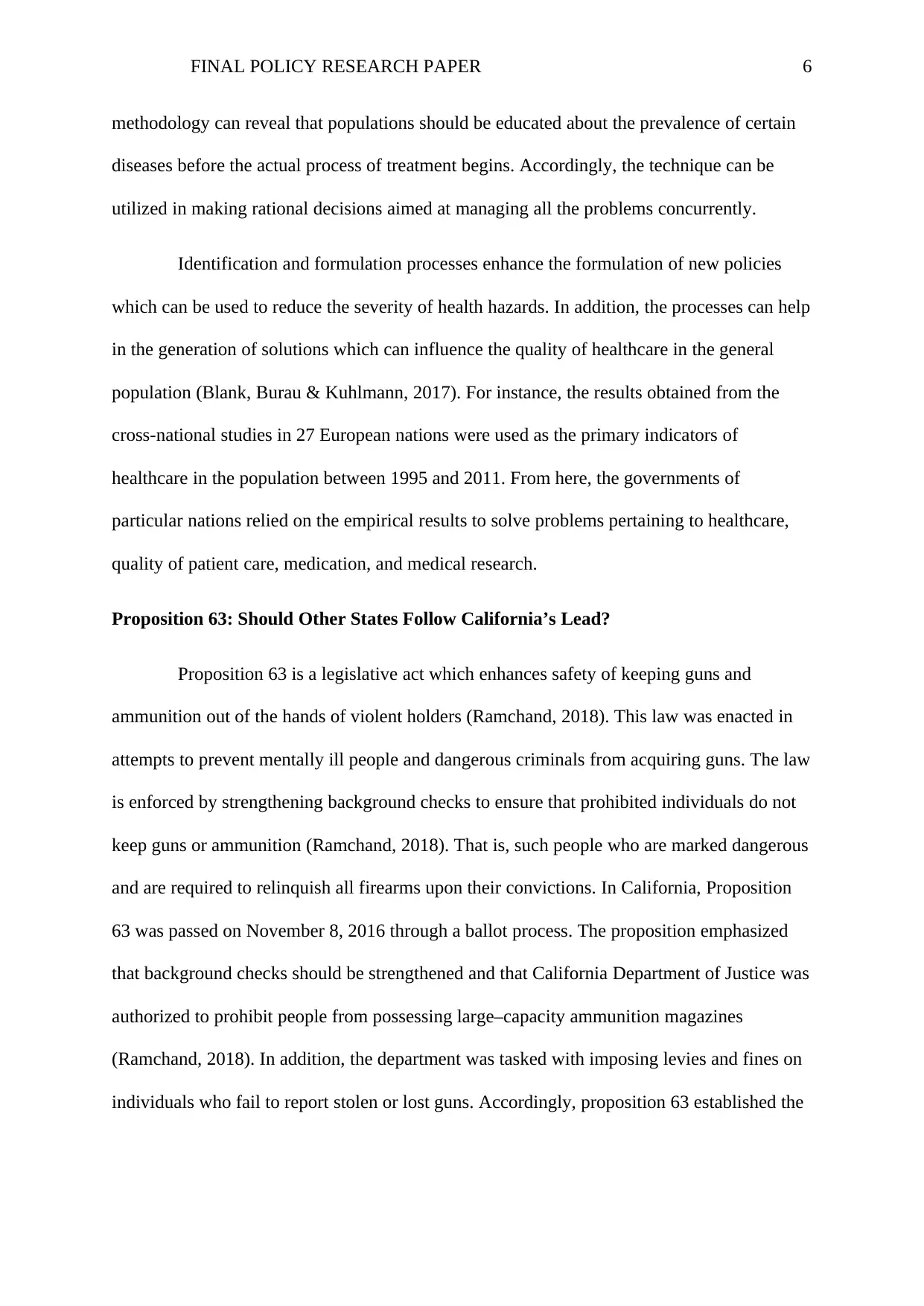
FINAL POLICY RESEARCH PAPER 6
methodology can reveal that populations should be educated about the prevalence of certain
diseases before the actual process of treatment begins. Accordingly, the technique can be
utilized in making rational decisions aimed at managing all the problems concurrently.
Identification and formulation processes enhance the formulation of new policies
which can be used to reduce the severity of health hazards. In addition, the processes can help
in the generation of solutions which can influence the quality of healthcare in the general
population (Blank, Burau & Kuhlmann, 2017). For instance, the results obtained from the
cross-national studies in 27 European nations were used as the primary indicators of
healthcare in the population between 1995 and 2011. From here, the governments of
particular nations relied on the empirical results to solve problems pertaining to healthcare,
quality of patient care, medication, and medical research.
Proposition 63: Should Other States Follow California’s Lead?
Proposition 63 is a legislative act which enhances safety of keeping guns and
ammunition out of the hands of violent holders (Ramchand, 2018). This law was enacted in
attempts to prevent mentally ill people and dangerous criminals from acquiring guns. The law
is enforced by strengthening background checks to ensure that prohibited individuals do not
keep guns or ammunition (Ramchand, 2018). That is, such people who are marked dangerous
and are required to relinquish all firearms upon their convictions. In California, Proposition
63 was passed on November 8, 2016 through a ballot process. The proposition emphasized
that background checks should be strengthened and that California Department of Justice was
authorized to prohibit people from possessing large–capacity ammunition magazines
(Ramchand, 2018). In addition, the department was tasked with imposing levies and fines on
individuals who fail to report stolen or lost guns. Accordingly, proposition 63 established the
methodology can reveal that populations should be educated about the prevalence of certain
diseases before the actual process of treatment begins. Accordingly, the technique can be
utilized in making rational decisions aimed at managing all the problems concurrently.
Identification and formulation processes enhance the formulation of new policies
which can be used to reduce the severity of health hazards. In addition, the processes can help
in the generation of solutions which can influence the quality of healthcare in the general
population (Blank, Burau & Kuhlmann, 2017). For instance, the results obtained from the
cross-national studies in 27 European nations were used as the primary indicators of
healthcare in the population between 1995 and 2011. From here, the governments of
particular nations relied on the empirical results to solve problems pertaining to healthcare,
quality of patient care, medication, and medical research.
Proposition 63: Should Other States Follow California’s Lead?
Proposition 63 is a legislative act which enhances safety of keeping guns and
ammunition out of the hands of violent holders (Ramchand, 2018). This law was enacted in
attempts to prevent mentally ill people and dangerous criminals from acquiring guns. The law
is enforced by strengthening background checks to ensure that prohibited individuals do not
keep guns or ammunition (Ramchand, 2018). That is, such people who are marked dangerous
and are required to relinquish all firearms upon their convictions. In California, Proposition
63 was passed on November 8, 2016 through a ballot process. The proposition emphasized
that background checks should be strengthened and that California Department of Justice was
authorized to prohibit people from possessing large–capacity ammunition magazines
(Ramchand, 2018). In addition, the department was tasked with imposing levies and fines on
individuals who fail to report stolen or lost guns. Accordingly, proposition 63 established the
⊘ This is a preview!⊘
Do you want full access?
Subscribe today to unlock all pages.

Trusted by 1+ million students worldwide
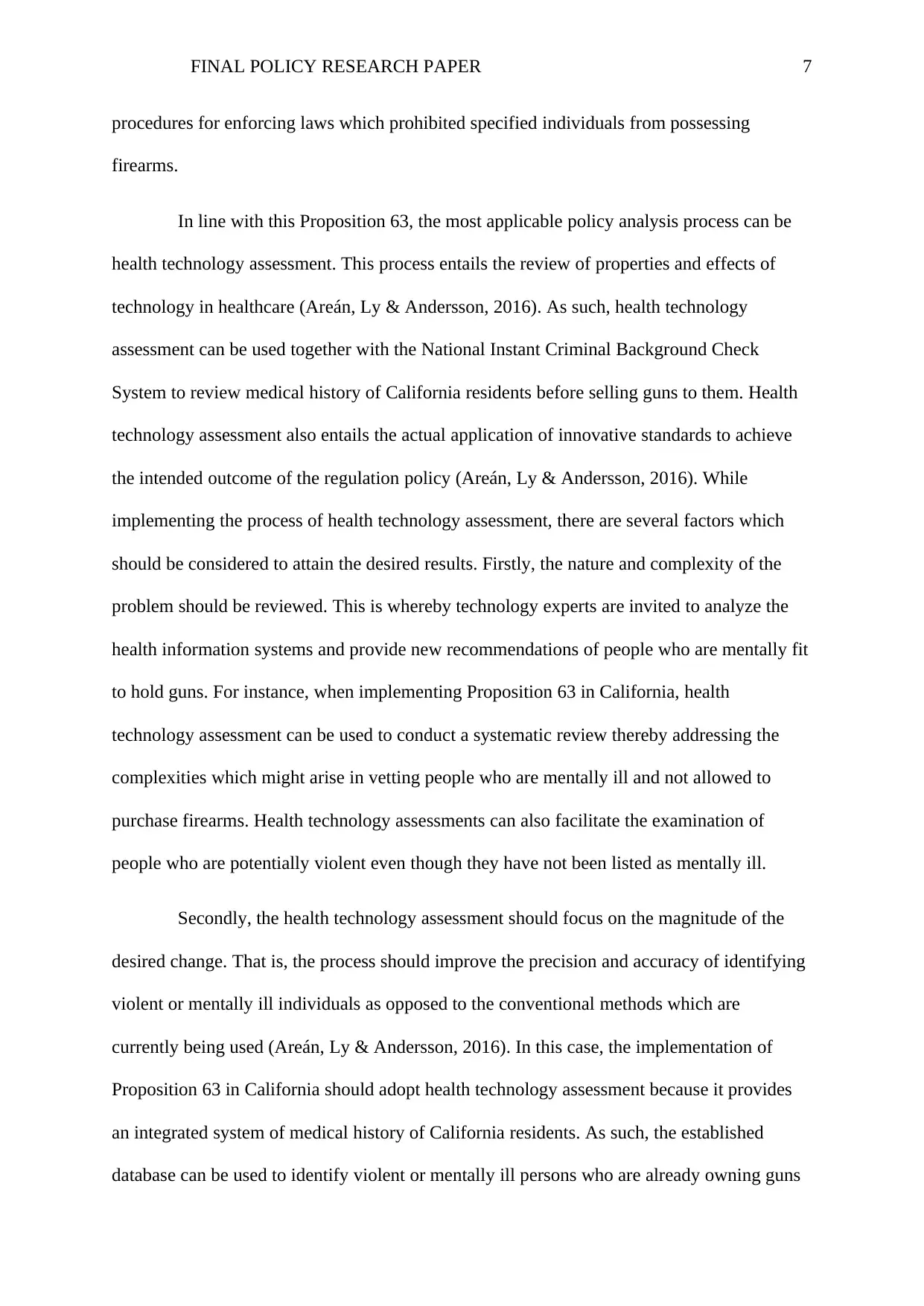
FINAL POLICY RESEARCH PAPER 7
procedures for enforcing laws which prohibited specified individuals from possessing
firearms.
In line with this Proposition 63, the most applicable policy analysis process can be
health technology assessment. This process entails the review of properties and effects of
technology in healthcare (Areán, Ly & Andersson, 2016). As such, health technology
assessment can be used together with the National Instant Criminal Background Check
System to review medical history of California residents before selling guns to them. Health
technology assessment also entails the actual application of innovative standards to achieve
the intended outcome of the regulation policy (Areán, Ly & Andersson, 2016). While
implementing the process of health technology assessment, there are several factors which
should be considered to attain the desired results. Firstly, the nature and complexity of the
problem should be reviewed. This is whereby technology experts are invited to analyze the
health information systems and provide new recommendations of people who are mentally fit
to hold guns. For instance, when implementing Proposition 63 in California, health
technology assessment can be used to conduct a systematic review thereby addressing the
complexities which might arise in vetting people who are mentally ill and not allowed to
purchase firearms. Health technology assessments can also facilitate the examination of
people who are potentially violent even though they have not been listed as mentally ill.
Secondly, the health technology assessment should focus on the magnitude of the
desired change. That is, the process should improve the precision and accuracy of identifying
violent or mentally ill individuals as opposed to the conventional methods which are
currently being used (Areán, Ly & Andersson, 2016). In this case, the implementation of
Proposition 63 in California should adopt health technology assessment because it provides
an integrated system of medical history of California residents. As such, the established
database can be used to identify violent or mentally ill persons who are already owning guns
procedures for enforcing laws which prohibited specified individuals from possessing
firearms.
In line with this Proposition 63, the most applicable policy analysis process can be
health technology assessment. This process entails the review of properties and effects of
technology in healthcare (Areán, Ly & Andersson, 2016). As such, health technology
assessment can be used together with the National Instant Criminal Background Check
System to review medical history of California residents before selling guns to them. Health
technology assessment also entails the actual application of innovative standards to achieve
the intended outcome of the regulation policy (Areán, Ly & Andersson, 2016). While
implementing the process of health technology assessment, there are several factors which
should be considered to attain the desired results. Firstly, the nature and complexity of the
problem should be reviewed. This is whereby technology experts are invited to analyze the
health information systems and provide new recommendations of people who are mentally fit
to hold guns. For instance, when implementing Proposition 63 in California, health
technology assessment can be used to conduct a systematic review thereby addressing the
complexities which might arise in vetting people who are mentally ill and not allowed to
purchase firearms. Health technology assessments can also facilitate the examination of
people who are potentially violent even though they have not been listed as mentally ill.
Secondly, the health technology assessment should focus on the magnitude of the
desired change. That is, the process should improve the precision and accuracy of identifying
violent or mentally ill individuals as opposed to the conventional methods which are
currently being used (Areán, Ly & Andersson, 2016). In this case, the implementation of
Proposition 63 in California should adopt health technology assessment because it provides
an integrated system of medical history of California residents. As such, the established
database can be used to identify violent or mentally ill persons who are already owning guns
Paraphrase This Document
Need a fresh take? Get an instant paraphrase of this document with our AI Paraphraser
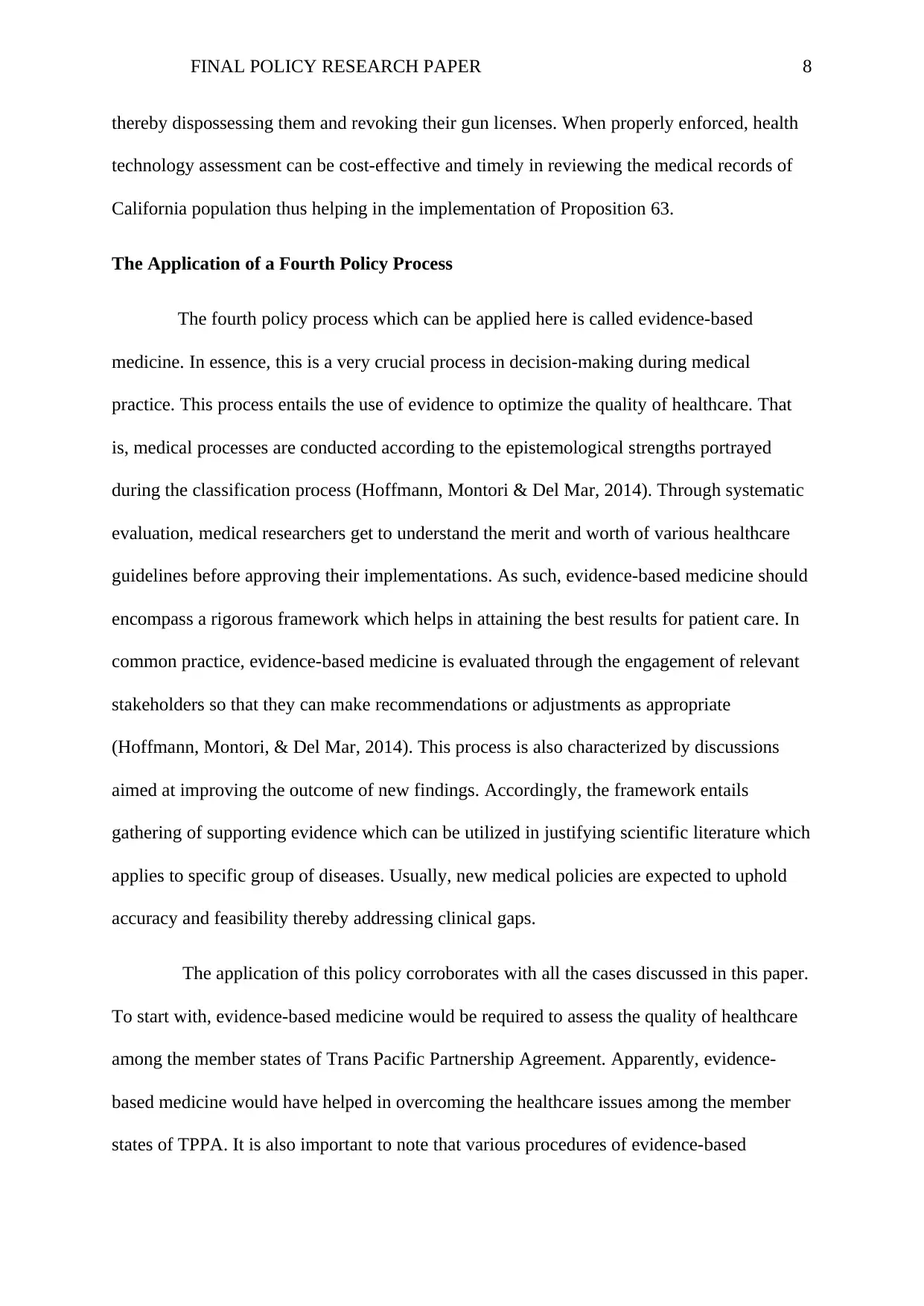
FINAL POLICY RESEARCH PAPER 8
thereby dispossessing them and revoking their gun licenses. When properly enforced, health
technology assessment can be cost-effective and timely in reviewing the medical records of
California population thus helping in the implementation of Proposition 63.
The Application of a Fourth Policy Process
The fourth policy process which can be applied here is called evidence-based
medicine. In essence, this is a very crucial process in decision-making during medical
practice. This process entails the use of evidence to optimize the quality of healthcare. That
is, medical processes are conducted according to the epistemological strengths portrayed
during the classification process (Hoffmann, Montori & Del Mar, 2014). Through systematic
evaluation, medical researchers get to understand the merit and worth of various healthcare
guidelines before approving their implementations. As such, evidence-based medicine should
encompass a rigorous framework which helps in attaining the best results for patient care. In
common practice, evidence-based medicine is evaluated through the engagement of relevant
stakeholders so that they can make recommendations or adjustments as appropriate
(Hoffmann, Montori, & Del Mar, 2014). This process is also characterized by discussions
aimed at improving the outcome of new findings. Accordingly, the framework entails
gathering of supporting evidence which can be utilized in justifying scientific literature which
applies to specific group of diseases. Usually, new medical policies are expected to uphold
accuracy and feasibility thereby addressing clinical gaps.
The application of this policy corroborates with all the cases discussed in this paper.
To start with, evidence-based medicine would be required to assess the quality of healthcare
among the member states of Trans Pacific Partnership Agreement. Apparently, evidence-
based medicine would have helped in overcoming the healthcare issues among the member
states of TPPA. It is also important to note that various procedures of evidence-based
thereby dispossessing them and revoking their gun licenses. When properly enforced, health
technology assessment can be cost-effective and timely in reviewing the medical records of
California population thus helping in the implementation of Proposition 63.
The Application of a Fourth Policy Process
The fourth policy process which can be applied here is called evidence-based
medicine. In essence, this is a very crucial process in decision-making during medical
practice. This process entails the use of evidence to optimize the quality of healthcare. That
is, medical processes are conducted according to the epistemological strengths portrayed
during the classification process (Hoffmann, Montori & Del Mar, 2014). Through systematic
evaluation, medical researchers get to understand the merit and worth of various healthcare
guidelines before approving their implementations. As such, evidence-based medicine should
encompass a rigorous framework which helps in attaining the best results for patient care. In
common practice, evidence-based medicine is evaluated through the engagement of relevant
stakeholders so that they can make recommendations or adjustments as appropriate
(Hoffmann, Montori, & Del Mar, 2014). This process is also characterized by discussions
aimed at improving the outcome of new findings. Accordingly, the framework entails
gathering of supporting evidence which can be utilized in justifying scientific literature which
applies to specific group of diseases. Usually, new medical policies are expected to uphold
accuracy and feasibility thereby addressing clinical gaps.
The application of this policy corroborates with all the cases discussed in this paper.
To start with, evidence-based medicine would be required to assess the quality of healthcare
among the member states of Trans Pacific Partnership Agreement. Apparently, evidence-
based medicine would have helped in overcoming the healthcare issues among the member
states of TPPA. It is also important to note that various procedures of evidence-based
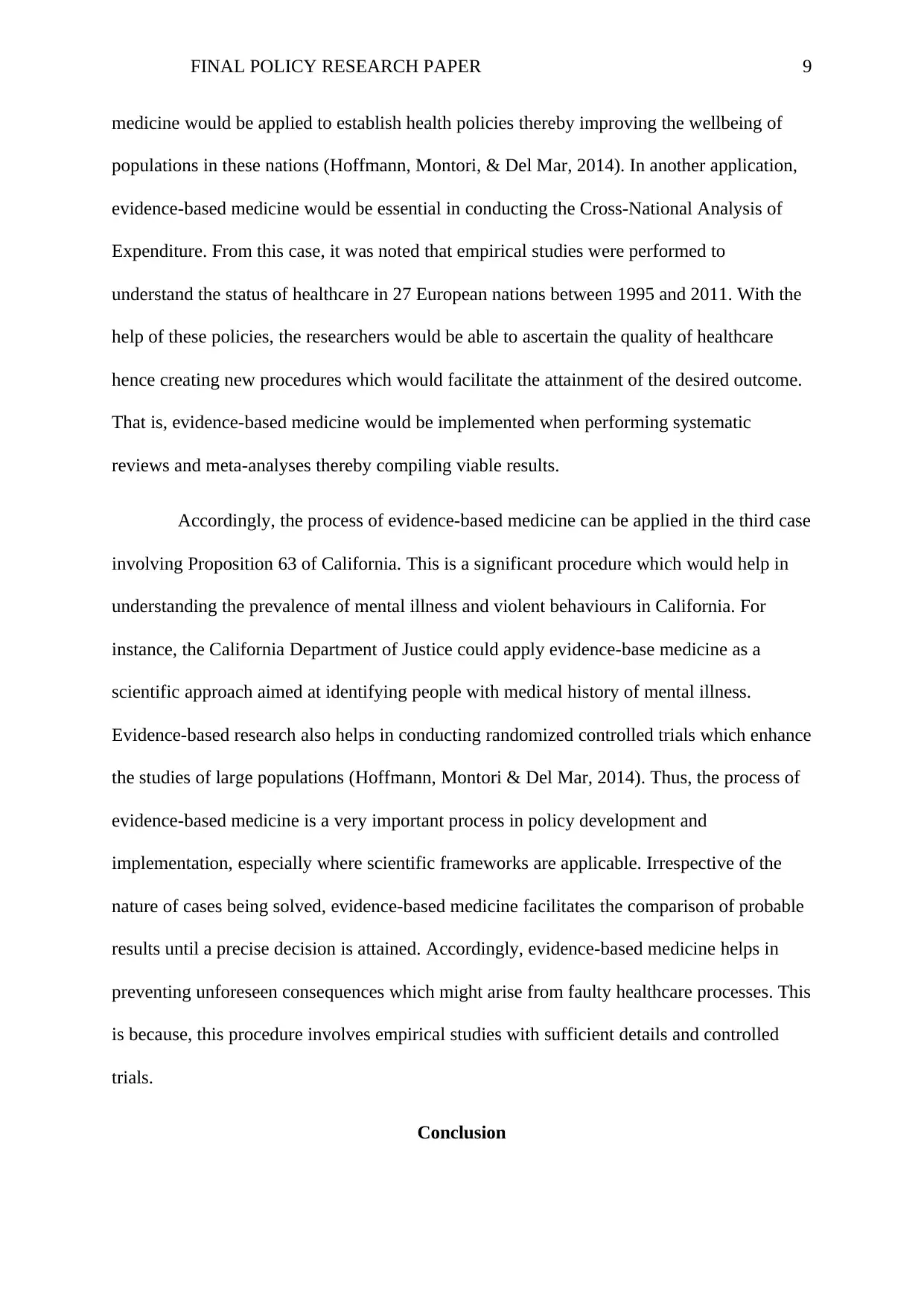
FINAL POLICY RESEARCH PAPER 9
medicine would be applied to establish health policies thereby improving the wellbeing of
populations in these nations (Hoffmann, Montori, & Del Mar, 2014). In another application,
evidence-based medicine would be essential in conducting the Cross-National Analysis of
Expenditure. From this case, it was noted that empirical studies were performed to
understand the status of healthcare in 27 European nations between 1995 and 2011. With the
help of these policies, the researchers would be able to ascertain the quality of healthcare
hence creating new procedures which would facilitate the attainment of the desired outcome.
That is, evidence-based medicine would be implemented when performing systematic
reviews and meta-analyses thereby compiling viable results.
Accordingly, the process of evidence-based medicine can be applied in the third case
involving Proposition 63 of California. This is a significant procedure which would help in
understanding the prevalence of mental illness and violent behaviours in California. For
instance, the California Department of Justice could apply evidence-base medicine as a
scientific approach aimed at identifying people with medical history of mental illness.
Evidence-based research also helps in conducting randomized controlled trials which enhance
the studies of large populations (Hoffmann, Montori & Del Mar, 2014). Thus, the process of
evidence-based medicine is a very important process in policy development and
implementation, especially where scientific frameworks are applicable. Irrespective of the
nature of cases being solved, evidence-based medicine facilitates the comparison of probable
results until a precise decision is attained. Accordingly, evidence-based medicine helps in
preventing unforeseen consequences which might arise from faulty healthcare processes. This
is because, this procedure involves empirical studies with sufficient details and controlled
trials.
Conclusion
medicine would be applied to establish health policies thereby improving the wellbeing of
populations in these nations (Hoffmann, Montori, & Del Mar, 2014). In another application,
evidence-based medicine would be essential in conducting the Cross-National Analysis of
Expenditure. From this case, it was noted that empirical studies were performed to
understand the status of healthcare in 27 European nations between 1995 and 2011. With the
help of these policies, the researchers would be able to ascertain the quality of healthcare
hence creating new procedures which would facilitate the attainment of the desired outcome.
That is, evidence-based medicine would be implemented when performing systematic
reviews and meta-analyses thereby compiling viable results.
Accordingly, the process of evidence-based medicine can be applied in the third case
involving Proposition 63 of California. This is a significant procedure which would help in
understanding the prevalence of mental illness and violent behaviours in California. For
instance, the California Department of Justice could apply evidence-base medicine as a
scientific approach aimed at identifying people with medical history of mental illness.
Evidence-based research also helps in conducting randomized controlled trials which enhance
the studies of large populations (Hoffmann, Montori & Del Mar, 2014). Thus, the process of
evidence-based medicine is a very important process in policy development and
implementation, especially where scientific frameworks are applicable. Irrespective of the
nature of cases being solved, evidence-based medicine facilitates the comparison of probable
results until a precise decision is attained. Accordingly, evidence-based medicine helps in
preventing unforeseen consequences which might arise from faulty healthcare processes. This
is because, this procedure involves empirical studies with sufficient details and controlled
trials.
Conclusion
⊘ This is a preview!⊘
Do you want full access?
Subscribe today to unlock all pages.

Trusted by 1+ million students worldwide
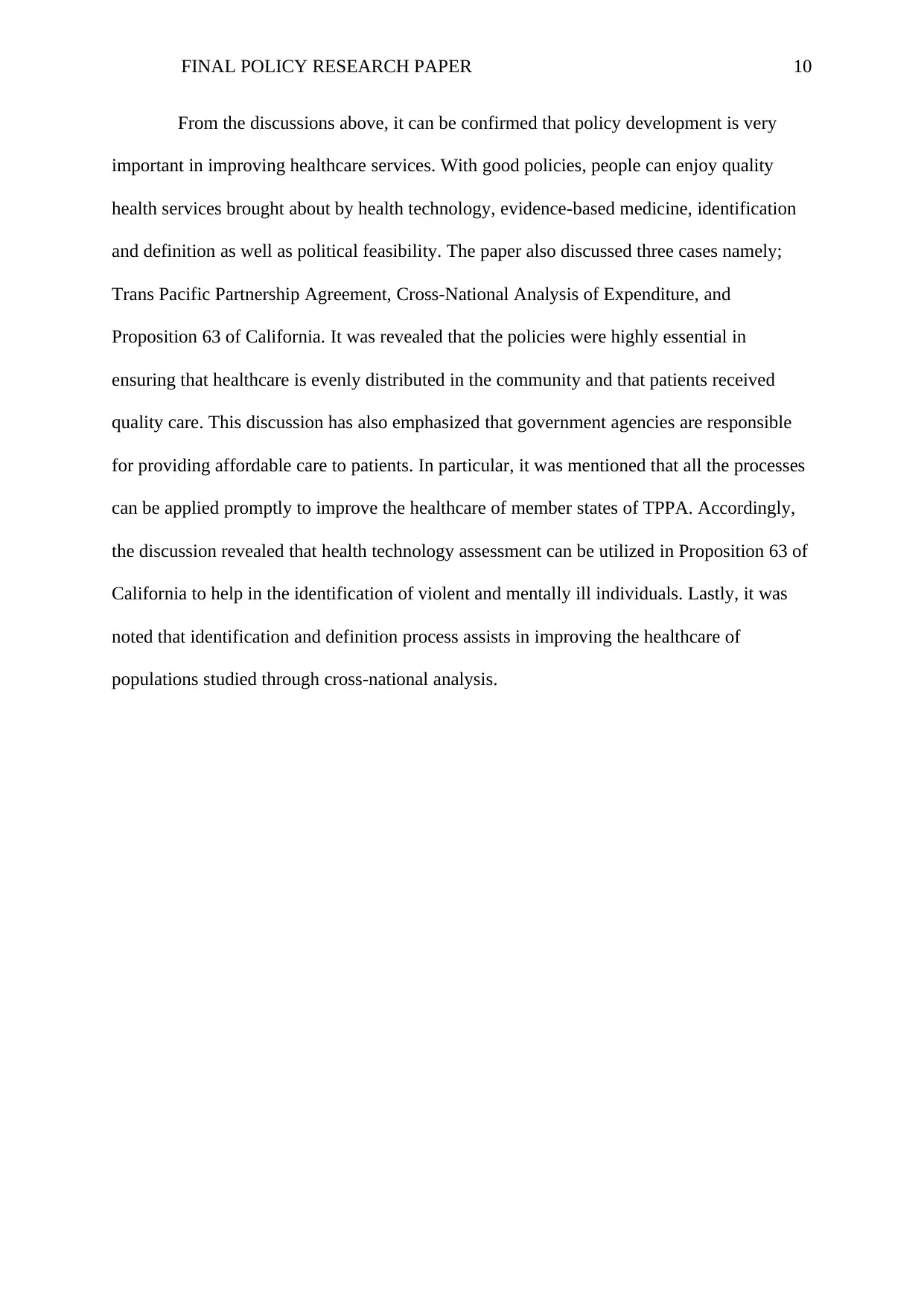
FINAL POLICY RESEARCH PAPER 10
From the discussions above, it can be confirmed that policy development is very
important in improving healthcare services. With good policies, people can enjoy quality
health services brought about by health technology, evidence-based medicine, identification
and definition as well as political feasibility. The paper also discussed three cases namely;
Trans Pacific Partnership Agreement, Cross-National Analysis of Expenditure, and
Proposition 63 of California. It was revealed that the policies were highly essential in
ensuring that healthcare is evenly distributed in the community and that patients received
quality care. This discussion has also emphasized that government agencies are responsible
for providing affordable care to patients. In particular, it was mentioned that all the processes
can be applied promptly to improve the healthcare of member states of TPPA. Accordingly,
the discussion revealed that health technology assessment can be utilized in Proposition 63 of
California to help in the identification of violent and mentally ill individuals. Lastly, it was
noted that identification and definition process assists in improving the healthcare of
populations studied through cross-national analysis.
From the discussions above, it can be confirmed that policy development is very
important in improving healthcare services. With good policies, people can enjoy quality
health services brought about by health technology, evidence-based medicine, identification
and definition as well as political feasibility. The paper also discussed three cases namely;
Trans Pacific Partnership Agreement, Cross-National Analysis of Expenditure, and
Proposition 63 of California. It was revealed that the policies were highly essential in
ensuring that healthcare is evenly distributed in the community and that patients received
quality care. This discussion has also emphasized that government agencies are responsible
for providing affordable care to patients. In particular, it was mentioned that all the processes
can be applied promptly to improve the healthcare of member states of TPPA. Accordingly,
the discussion revealed that health technology assessment can be utilized in Proposition 63 of
California to help in the identification of violent and mentally ill individuals. Lastly, it was
noted that identification and definition process assists in improving the healthcare of
populations studied through cross-national analysis.
Paraphrase This Document
Need a fresh take? Get an instant paraphrase of this document with our AI Paraphraser
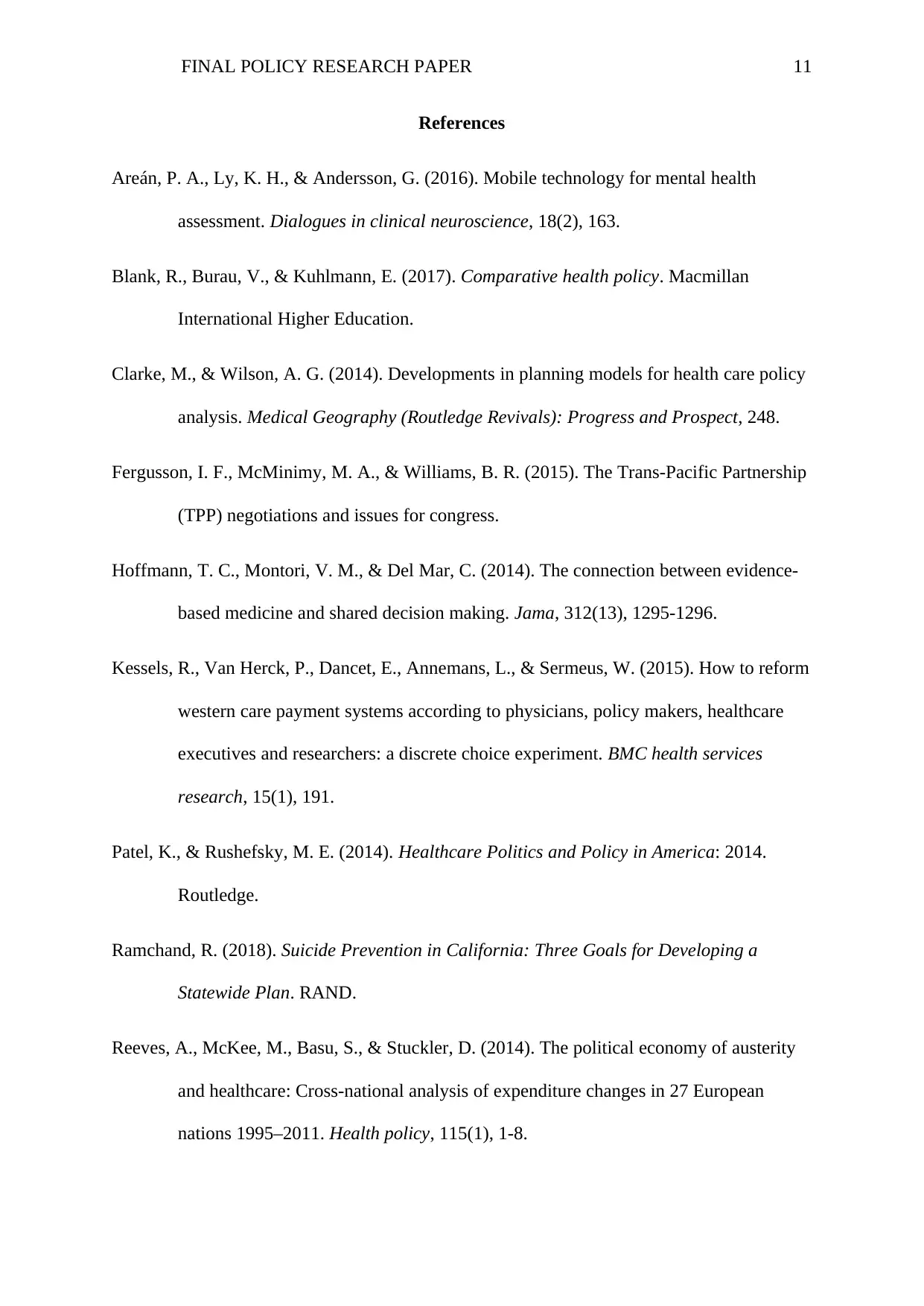
FINAL POLICY RESEARCH PAPER 11
References
Areán, P. A., Ly, K. H., & Andersson, G. (2016). Mobile technology for mental health
assessment. Dialogues in clinical neuroscience, 18(2), 163.
Blank, R., Burau, V., & Kuhlmann, E. (2017). Comparative health policy. Macmillan
International Higher Education.
Clarke, M., & Wilson, A. G. (2014). Developments in planning models for health care policy
analysis. Medical Geography (Routledge Revivals): Progress and Prospect, 248.
Fergusson, I. F., McMinimy, M. A., & Williams, B. R. (2015). The Trans-Pacific Partnership
(TPP) negotiations and issues for congress.
Hoffmann, T. C., Montori, V. M., & Del Mar, C. (2014). The connection between evidence-
based medicine and shared decision making. Jama, 312(13), 1295-1296.
Kessels, R., Van Herck, P., Dancet, E., Annemans, L., & Sermeus, W. (2015). How to reform
western care payment systems according to physicians, policy makers, healthcare
executives and researchers: a discrete choice experiment. BMC health services
research, 15(1), 191.
Patel, K., & Rushefsky, M. E. (2014). Healthcare Politics and Policy in America: 2014.
Routledge.
Ramchand, R. (2018). Suicide Prevention in California: Three Goals for Developing a
Statewide Plan. RAND.
Reeves, A., McKee, M., Basu, S., & Stuckler, D. (2014). The political economy of austerity
and healthcare: Cross-national analysis of expenditure changes in 27 European
nations 1995–2011. Health policy, 115(1), 1-8.
References
Areán, P. A., Ly, K. H., & Andersson, G. (2016). Mobile technology for mental health
assessment. Dialogues in clinical neuroscience, 18(2), 163.
Blank, R., Burau, V., & Kuhlmann, E. (2017). Comparative health policy. Macmillan
International Higher Education.
Clarke, M., & Wilson, A. G. (2014). Developments in planning models for health care policy
analysis. Medical Geography (Routledge Revivals): Progress and Prospect, 248.
Fergusson, I. F., McMinimy, M. A., & Williams, B. R. (2015). The Trans-Pacific Partnership
(TPP) negotiations and issues for congress.
Hoffmann, T. C., Montori, V. M., & Del Mar, C. (2014). The connection between evidence-
based medicine and shared decision making. Jama, 312(13), 1295-1296.
Kessels, R., Van Herck, P., Dancet, E., Annemans, L., & Sermeus, W. (2015). How to reform
western care payment systems according to physicians, policy makers, healthcare
executives and researchers: a discrete choice experiment. BMC health services
research, 15(1), 191.
Patel, K., & Rushefsky, M. E. (2014). Healthcare Politics and Policy in America: 2014.
Routledge.
Ramchand, R. (2018). Suicide Prevention in California: Three Goals for Developing a
Statewide Plan. RAND.
Reeves, A., McKee, M., Basu, S., & Stuckler, D. (2014). The political economy of austerity
and healthcare: Cross-national analysis of expenditure changes in 27 European
nations 1995–2011. Health policy, 115(1), 1-8.
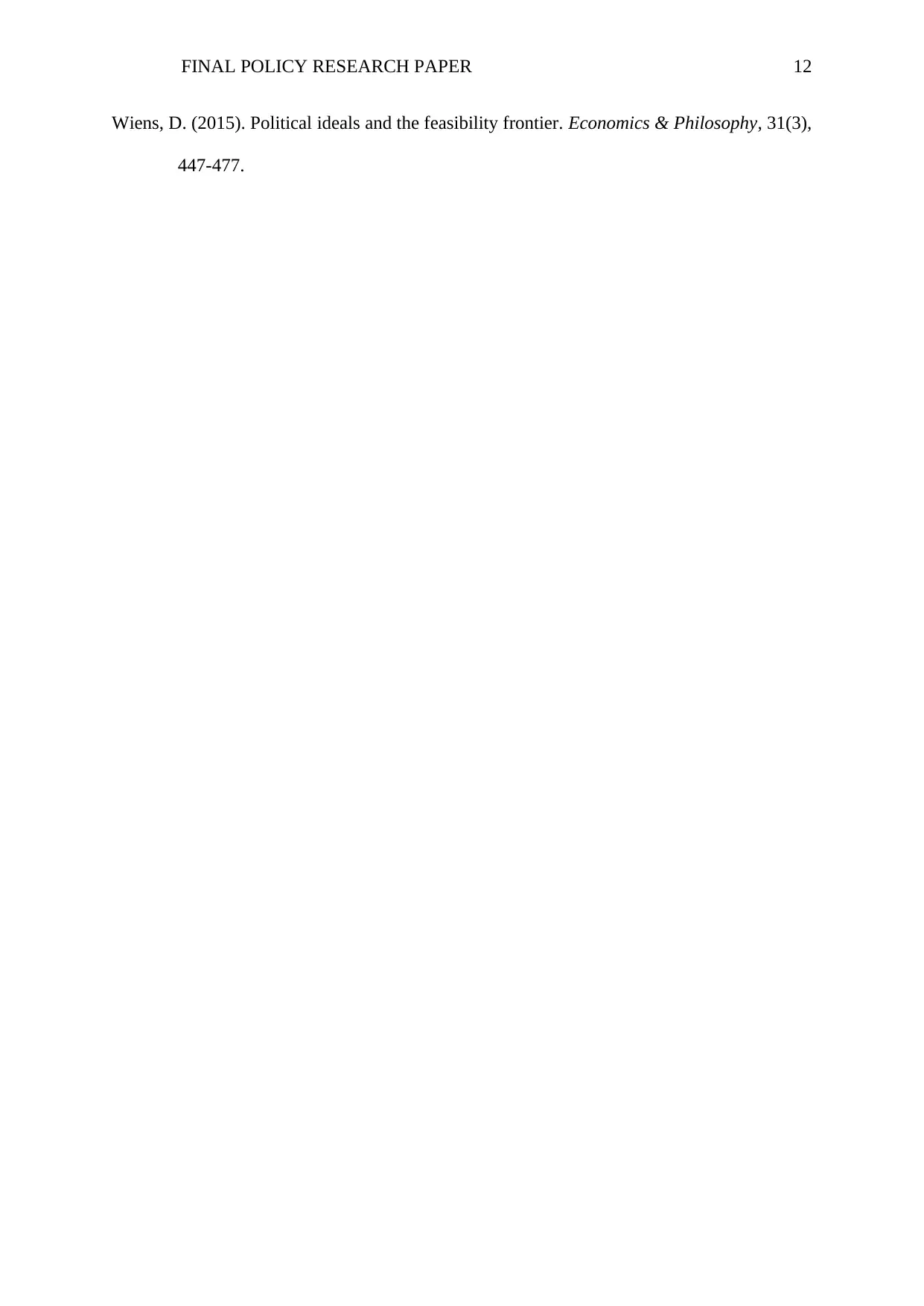
FINAL POLICY RESEARCH PAPER 12
Wiens, D. (2015). Political ideals and the feasibility frontier. Economics & Philosophy, 31(3),
447-477.
Wiens, D. (2015). Political ideals and the feasibility frontier. Economics & Philosophy, 31(3),
447-477.
⊘ This is a preview!⊘
Do you want full access?
Subscribe today to unlock all pages.

Trusted by 1+ million students worldwide
1 out of 12
Your All-in-One AI-Powered Toolkit for Academic Success.
+13062052269
info@desklib.com
Available 24*7 on WhatsApp / Email
![[object Object]](/_next/static/media/star-bottom.7253800d.svg)
Unlock your academic potential
Copyright © 2020–2025 A2Z Services. All Rights Reserved. Developed and managed by ZUCOL.